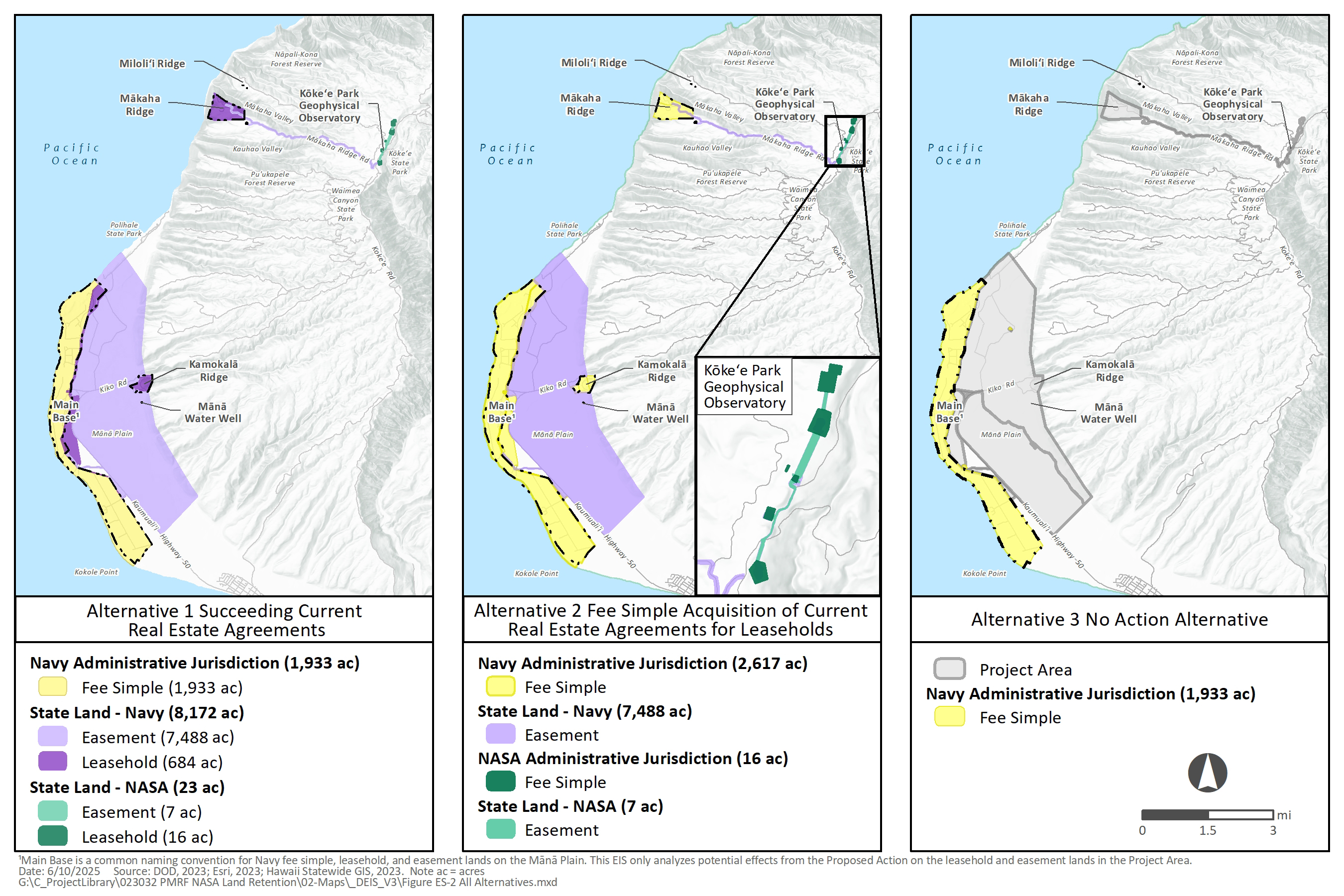Proposed Action and Alternatives
Pacific Missile Range Facility and Kōkeʻe Park Geophysical Observatory Real Estate Environmental Impact Statement
Proposed Action
The Navy proposes to retain the use of 8,172 acres of State of Hawai‘i lands on Kaua‘i in support of continued military training, testing, and facility operations at PMRF. NASA proposes to retain the use of 23 acres of state lands on Kaua‘i in support of continued operations including measurements of the Earth’s rotation and local land motion at Kōkeʻe Park Geophysical Observatory (KPGO). The Navy and NASA existing real estate agreements for state lands were established in 1964 and 1965 and are set to expire between 2027 and 2030.
Alternative 1: Succeeding Current Real Estate Agreements
Under this alternative, the Navy and NASA would apply to the Board of Land and Natural Resources (BLNR) for new long-term real estate agreements at fair market value, for a similar duration, and for the same uses as the current leases and easements. The Navy’s agreements would include 684 acres of land leased exclusively by the Navy and 7,488 acres of easement lands (for a total of 8,172 acres). NASA’s agreements would include 16 acres of land leased exclusively by NASA and 7 acres of easement lands (for a total of 23 acres). NASA would enter into a new real estate agreement with the Navy for continued use of portions of the leasehold and easement lands. Under this alternative, there would be no changes to the type or frequency of current activities occurring on state leased and easement lands. This alternative would not change any use or maintenance of existing infrastructure and would not involve construction, renovation, or demolition of facilities. This alternative would also preserve the Navy- and NASA-funded natural and cultural resource management activities on the leased and easement lands.
Alternative 2: Fee Simple Acquisition of Current Real Estate Agreements for Leaseholds
Under this alternative, the Navy and NASA would pursue fee simple acquisition at fair market value of up to 700 acres (684 acres for Navy use and 16 acres for NASA use) of leaseholds and otherwise obtain use of the same easement lands as described in Alternative 1. The new Navy fee simple land of 684 acres would include 392 acres of land at the Main Base[1], 89 acres at Kamokalā Ridge, 0.29 acre at the Mānā Water Well, 0.015 acre at Miloli‘i Ridge, and 203 acres at Mākaha Ridge, and the NASA fee simple land would include 16 acres at KPGO. This acreage would be transferred from ownership by the State of Hawai‘i to the U.S. Government. This alternative would not change any use or maintenance of existing infrastructure and would not involve construction, renovation, or demolition of facilities.
[1] Note that “Main Base” is a common naming convention for Navy fee simple, leasehold, and easement lands on the Mānā Plain. This EIS only analyzes potential effects from the Proposed Action on the leasehold and easement lands in the Project Area.
Alternative 3: No Action Alternative
Under the No Action Alternative, the state would not grant Navy and NASA any new real estate agreements for the state lands on Kaua‘i (8,172 acres Navy, 23 acres NASA) after expiration of the leases and easements between 2027 and 2030.
In this EIS, the No Action Alternative consists of the potential steps that would take place if the new real estate agreements for leases and easements are not granted to the Navy and NASA after their expiration. The analysis of the environmental resources also examines the loss of the Navy and NASA programs and potential effects to the resource; however, the full effect of such an alternative cannot be determined due to the uncertainty of how the Navy and NASA would reduce their operations, the state’s future management of its returned lands, and what each party may negotiate. Among other factors, negotiations between the state and the Navy and the state and NASA would determine whether existing infrastructure on the state lands would be removed or remain in place and what, if any environmental remediation would be required before the State of Hawai‘i reacquired control of the property.
Alternatives Screening Process
The Navy and NASA used the following screening factors to select reasonable alternatives that would allow their missions to be fulfilled:
- Maintain long-term use of state lands currently used to support Department of Defense (DoD) and NASA missions on Kaua‘i;
- Preserve current DoD and NASA operations on Kaua‘i;
- Retain existing DoD and NASA infrastructure on Kaua‘i; and
- Support Department of Land and Natural Resources management of public lands and associated environmental and conservation programs on Kaua‘i.
All screening factors must be met for an alternative to be considered reasonable.
Alternatives Carried Forward for Analysis

Alternatives Considered but Not Carried Forward for Detailed Analysis
|
Alternative |
Description |
|
Succeeding Leases and Easements Except for Current Leases at Mākaha Ridge and KPGO |
The Navy and NASA would obtain succeeding leases and easements on leased land not currently located in the State of Hawai‘i’s Conservation District. These would include leaseholds at Main Base, Kamokalā Ridge, Mānā Water Well, and Miloli‘i Ridge, but would not include succeeding leaseholds or easements at Mākaha Ridge or KPGO. |
|
Succeeding Leases Only with No Easements |
The Navy and NASA would only obtain succeeding lease agreements and not succeeding easements. These would include succeeding leaseholds at Main Base, Kamokalā Ridge, Mānā Water Well, Miloli‘i Ridge, Mākaha Ridge, and KPGO, but not easements at Main Base, Kamokalā Ridge, Mākaha Ridge, or KPGO. |
|
Shorter Duration |
The Navy and NASA would obtain succeeding real estate agreements for a short duration (less than 25 years). |
